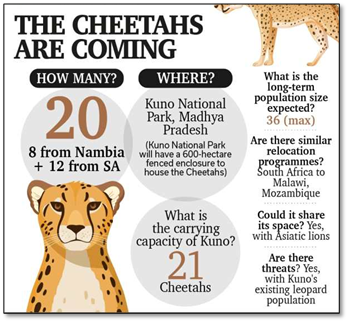

Context
Recently, Supreme Court (SC) urged the government to transfer the Cheetahs to a more conducive environment due to alarming rate of death of Cheetahs since March 2023.
- SC has also asked government to file a detailed affidavit on the circumstances on death of the cheetahs before the next hearing that is scheduled for 1st August, 2023.
Reintroduction Plan for Cheetahs:
- Aim: To establish a viable and secure cheetah population in India promoting its conservation.
- Twenty cheetahs have been brought from Namibia and South Africa since September 2022 to reintroduce them into Indian habitat.
- Eight of the animals have died, but the long-term plan is to gradually release the animals into the wild and keep adding more until a self-sustaining population is established.
- Four of the cheetahs have already been released into the wild, but the remaining cheetahs will remain in the acclimatisation camps for the duration of the monsoon season.
- The National Tiger Conservation Authority (NTCA) is the nodal body for Project Cheetah.

Why Cheetahs being relocated to India?
- The cheetah is the only large carnivore to have gone extinct in India, primarily due to hunting and habitat loss.
- Maharaja Ramanuj Pratap Singh Deoof Korea, Madhya Pradesh, is widely believed to have killed the last three recorded cheetahs in India.
- In 1952, the Indian government officially declared the Cheetah extinct in the country.
Demand for Reintroduction of Cheetah:
- The State Wildlife Board of Andhra Pradesh was the first to suggest the policy in 1955, on an experimental basis in two districts of the state.
- In the 1970s, the Department of Environment formally requested Iran, which had 300 Asiatic cheetahs at the time, for some cheetahs.
- However, the Shah of Iran was deposed before any deal could be reached.
- Attempts to bring cheetahs to India were revived once more in 2009, and the Wildlife Trust of Indiaconducted a meeting to discuss the feasibility of cheetah reintroduction.
- Several sites were chosen, of which Kuno-Palpur National Park (KNP) was seen as the most suitable.
- This was because the area had a large habitat area available and significant investments had already been made to displace the villagers inhabiting the site.
Reasons for the death:
- Around 40% of the cheetahs out of 20 that were introduced in India under Reintroduction of Cheetah project died in KNP in last four months.
- As per the report for analysing reasons for death:
- Sasha, a female cheetah, died due to chronic renal failure.
- Uday, a male cheetah, suffered a cardiopulmonary failure.
- Cheetah Daksha died of traumatic shock, the report said without elaborating on the causes.
- Male cheetah Tejas died due to traumatic shock.
- Suraj, the fifth one brought in from Africa, also died of traumatic shock.
- Three cubs born at the park died of heatstroke.
- Radio Collars: Two cheetahs died of suspected septicaemia due to neck wounds caused by radio collars in Kuno last week.
- If there is constant rainfall then the skin under the collar becomes infected due to constant moistness resulting in a systematic infection brought on by flies and maggots, eventually causing death.
- Additionally collar affects the athleticism of cheetahs as it amounts to nearly 7kg of massive weight during sprinting eventually causing injuries.


